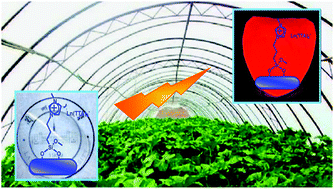Efficient visible and near-infrared photoluminescent attapulgite-based lanthanide one-dimensional nanomaterials assembled by ion-pairing interactions†
Abstract
Attapulgite, a one-dimensional fibrillar nanomaterial present in nature, with its extreme stability, is a promising material to act as a new carrier of luminescent lanthanide complexes for further applications. Herein, a series of lanthanide complexes Na[Ln(TTA)4] have been attached to attapulgite (Atta) via ion-pairing interactions, generating the first example of attapulgite-based visible and near-infrared (NIR) luminescent lanthanide one-dimensional nanomaterials, where TTA is 2-thenoyltrifluoroacetonate and Ln is Eu, Sm, Nd, Er or Yb. The hybrid materials were characterized by CHN elemental analysis, inductively coupled plasma-atomic emission spectroscopy (ICP), powder X-ray diffraction (PXRD), thermogravimetry (TG), transmission electron microscopy (TEM), and UV-vis absorption spectra. In order to investigate the photophysical behaviours of these materials, the visible and NIR luminescent spectra and the energy transfer process have been systematically investigated. Moreover, efforts have been made to produce Eu- and Sm-based plastic attapulgite materials by utilizing poly(methyl methacrylate) (PMMA) matrices, and the dispersibility of the lanthanide-doped hybrids in PMMA provides them with a high mechanical strength. The lanthanide-doped attapulgite appears to be an interesting material for photophysical applications. The results of this work would have potential significance for the design and assembly of luminescent lanthanide materials for light-emitting diodes (LED), sunlight-conversion films, optical amplifiers, solar concentrators, and lasers.


 Please wait while we load your content...
Please wait while we load your content...